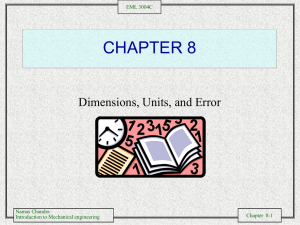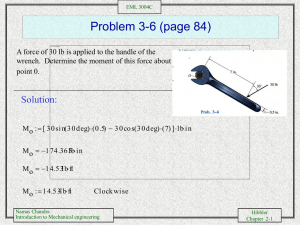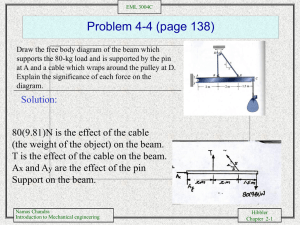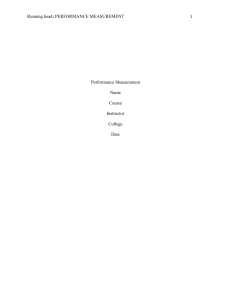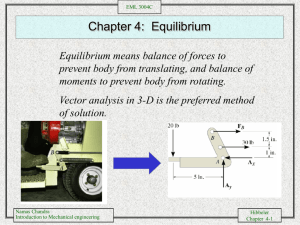Materials and Mechanical Engineering
advertisement
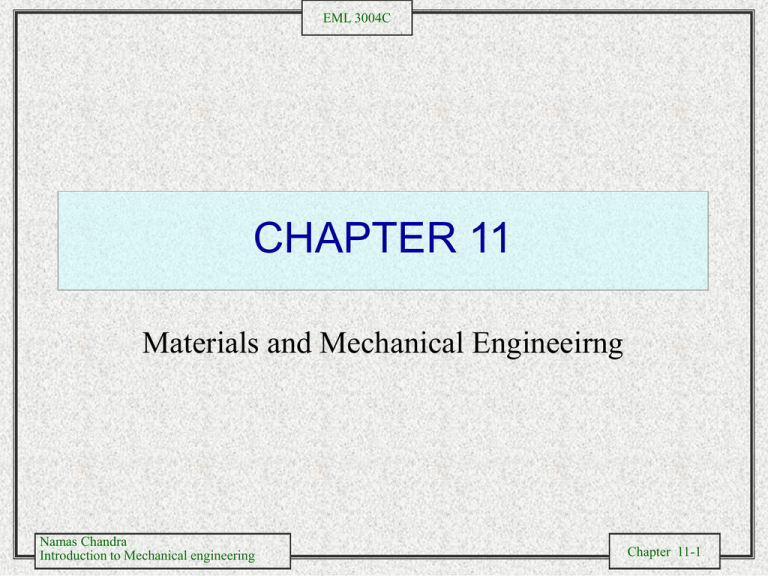
EML 3004C CHAPTER 11 Materials and Mechanical Engineeirng Namas Chandra Introduction to Mechanical engineering Chapter 11-1 EML 3004C Relative Mechanical Properties of Materials at Room Temperature TABLE 2.1 Strength Glass fibers Graphite fibers Kevlar fibers Carbides Molybdenum Steels Tantalum Titanium Copper Reinforced Reinforced Thermoplastics Lead Hardness Diamond Cubic boron nitride Carbides Hardened steels Titanium Cast irons Copper Thermosets Magnesium thermosets thermoplastics Lead Rubbers Namas Chandra Introduction to Mechanical engineering Toughness Ductile metals Reinforced plastics Thermoplastics Wood Thermosets Ceramics Glass Ceramics Reinforced Thermoplastics Tin Thermoplastics Stiffness Diamond Carbides Tungsten Steel Copper Titanium Aluminum Tantalum plastics Wood Thermosets Strength/Density Reinforced plastics Titanium Steel Aluminum Magnesium Beryllium Copper Chapter 11-2 EML 3004C Tensile-Test Specimen and Machine (b) Figure 2.1 (a) A standard tensile-test specimen before and after pulling, showing original and final gage lengths. (b) A typical tensile-testing machine. Namas Chandra Introduction to Mechanical engineering Chapter 11-3 EML 3004C Stress-Strain Curve Figure 2.2 A typical stressstrain curve obtained from a tension test, showing various features. Namas Chandra Introduction to Mechanical engineering Chapter 11-4 EML 3004C Mechanical Properties of Various Materials at Room Temperature TABLE 2.2 Mechanical Properties of Various Materials at Room Temperature Metals (Wrought) E (GPa) Y (MPa) UTS (MPa) Elongation in 50 mm (%) Aluminum and its alloys Copper and its alloys Lead and its alloys Magnesium and its alloys Molybdenum and its alloys Nickel and its alloys Steels Titanium and its alloys Tungsten and its alloys 69–79 105–150 14 41–45 330–360 180–214 190–200 80–130 350–400 35–550 76–1100 14 130–305 80–2070 105–1200 205–1725 344–1380 550–690 90–600 140–1310 20–55 240–380 90–2340 345–1450 415–1750 415–1450 620–760 45–4 65–3 50–9 21–5 40–30 60–5 65–2 25–7 0 Nonmetallic materials Ceramics 70–1000 — 140–2600 0 Diamond 820–1050 — — — Glass and porcelain 70-80 — 140 — Rubbers 0.01–0.1 — — — Thermoplastics 1.4–3.4 — 7–80 1000–5 Thermoplastics, reinforced 2–50 — 20–120 10–1 Thermosets 3.5–17 — 35–170 0 Boron fibers 380 — 3500 0 Carbon fibers 275–415 — 2000–3000 0 Glass fibers 73–85 — 3500–4600 0 Kevlar fibers 62–117 — 2800 0 Note: In the upper table the lowest values for E, Y, and UTS and the highest values for elongation are for pure metals. Multiply gigapascals (GPa) by 145,000 to obtain pounds per square in. (psi), megapascals (MPa) by 145 to obtain psi. Namas Chandra Introduction to Mechanical engineering Chapter 11-5 EML 3004C Loading and Unloading of Tensile-Test Specimen Figure 2.3 Schematic illustration of the loading and the unloading of a tensile- test specimen. Note that, during unloading, the curve follows a path parallel to the original elastic slope. Namas Chandra Introduction to Mechanical engineering Chapter 11-6 EML 3004C Elongation versus % Area Reduction Approximate relationship between elongation and tensile reduction of area for various groups of metals. Namas Chandra Introduction to Mechanical engineering Chapter 11-7 EML 3004C Construction of True Stress-True Strain Curve (a) Load-elongation curve in tension testing of a stainless steel specimen. (b) Engineering stressengineering strain curve, drawn from the data in (a.) (c) True stress-true strain curve, drawn from the data in (b). Note that this curve has a positive slope, indicating that the material is becoming stronger as it is strained. (d) True stress-true strain curve plotted on log-log paper and based on the corrected curve in ©. The correction is due to the triaxial state of stress that exists in the necked region of a specimen. Namas Chandra Introduction to Mechanical engineering Chapter 11-8 EML 3004C Typical Values for K and n at Room Temperature TABLE Aluminum 1100–O 2024–T4 6061–O 6061–T6 7075–O Brass 70–30, annealed 85–15, cold-rolled Cobalt-base alloy, heat-treated Copper, annealed Steel Low-C annealed 4135 annealed 4135 cold-rolled 4340 annealed 304 stainless, annealed 410 stainless, annealed Namas Chandra Introduction to Mechanical engineering K (MPa) n 180 690 205 410 400 0.20 0.16 0.20 0.05 0.17 900 580 2070 315 0.49 0.34 0.50 0.54 530 1015 1100 640 1275 960 0.26 0.17 0.14 0.15 0.45 0.10 Chapter 11-9 EML 3004C True Stress-True Strain Curves Figure 2.6 True stress-true strain curves in tension at room temperature for various metals. The curves start at a finite level of stress: The elastic regions have too steep a slope to be shown in this figure, and so each curve starts at the yield stress, Y, of the material. Namas Chandra Introduction to Mechanical engineering Chapter 11-10 EML 3004C Temperature Effects on Stress-Strain Curves Figure Typical effects of temperature on stress-strain curves. Note that temperature affects the modulus of elasticity, the yield stress, the ultimate tensile strength, and the toughness (area under the curve) of materials. Namas Chandra Introduction to Mechanical engineering Chapter 11-11 EML 3004C Typical Ranges of Strain and Deformation Rate in Manufacturing Processes TABLE Process Cold working Forging, rolling Wire and tube drawing Explosive forming Hot working and warm working Forging, rolling Extrusion Machining Sheet-metal forming Superplastic forming Namas Chandra Introduction to Mechanical engineering True strain Deformation rate (m/s) 0.1–0.5 0.05–0.5 0.05–0.2 0.1–100 0.1–100 10–100 0.1–0.5 2–5 1–10 0.1–0.5 0.2–3 0.1–30 0.1–1 0.1–100 0.05–2 -4 -2 10 -10 Chapter 11-12 EML 3004C Effect of Strain Rate on Ultimate Tensile Strength The effect of strain rate on the ultimate tensile strength for aluminum. Note that, as the temperature increases, the slopes of the curves increase; thus, strength becomes more and more sensitive to strain rate as temperature increases. Source: J. H. Hollomon. Namas Chandra Introduction to Mechanical engineering Chapter 11-13 EML 3004C Disk and Torsion-Test Specimens Disk test on a brittle material, showing the direction of loading and the fracture path. Typical torsion-test specimen; it is mounted between the two heads of a testing machine and twisted. Note the shear deformation of an element in the reduced section of the specimen. Namas Chandra Introduction to Mechanical engineering Chapter 11-14 EML 3004C Bending Two bend-test methods for brittle materials: (a) three-point bending; (b) four-point bending. The areas on the beams represent the bending-moment diagrams, described in texts on mechanics of solids. Note the region of constant maximum bending moment in (b); by contrast, the maximum bending moment occurs only at the center of the specimen in (a). Namas Chandra Introduction to Mechanical engineering Chapter 11-15 EML 3004C Hardness Tests General characteristics of hardness-testing methods and formulas for calculating hardness. The quantity P is the load applied. Source: H. W. Hayden, et al., The Structure and Properties of Materials, Vol. III (John Wiley & Sons, 1965). Namas Chandra Introduction to Mechanical engineering Chapter 11-16 EML 3004C Brinell Testing (c) Namas Chandra Introduction to Mechanical engineering Indentation geometry in Brinell testing; (a) annealed metal; (b) work-hardened metal; (c) deformation of mild steel under a spherical indenter. Note that the depth of the permanently deformed zone is about one order of magnitude larger than the depth of indentation. For a hardness test to be valid, this zone should be fully developed in the material. Source: M. C. Shaw and C. T. Yang. Chapter 11-17 EML 3004C Hardness Conversion Chart Chart for converting various hardness scales. Note the limited range of most scales. Because of the many factors involved, these conversions are approximate. Namas Chandra Introduction to Mechanical engineering Chapter 11-18 EML 3004C S-N Curves Typical S-N curves for two metals. Note that, unlike steel, aluminum does not have an endurance limit. Namas Chandra Introduction to Mechanical engineering Chapter 11-19 EML 3004C Creep Curve Figure 2.17 Schematic illustration of a typical creep curve. The linear segment of the curve (secondary) is used in designing components for a specific creep life. Namas Chandra Introduction to Mechanical engineering Chapter 11-20 EML 3004C Impact Test Specimens Impact test specimens: (a) Charpy; (b) Izod. Namas Chandra Introduction to Mechanical engineering Chapter 11-21 EML 3004C Failures of Materials and Fractures in Tension Schematic illustration of types of failures in materials: (a) necking and fracture of ductile materials; (b) Buckling of ductile materials under a compressive load; (c) fracture of brittle materials in compression; (d) cracking on the barreled surface of ductile materials in compression. Schematic illustration of the types of fracture in tension: (a) brittle fracture in polycrystalline metals; (b) shear fracture in ductile single crystals--see also Fig. 1.6a; (c) ductile cup-and-cone fracture in polycrystalline metals; (d) complete ductile fracture in polycrystalline metals, with 100% reduction of area. Namas Chandra Introduction to Mechanical engineering Chapter 11-22 EML 3004C Ductile Fracture Surface of ductile fracture in lowcarbon steel, showing dimples. Fracture is usually initiated at impurities, inclusions, or preexisting voids (microporosity) in the metal. Source: K.-H. Habig and D. Klaffke. Photo by BAM Berlin/Germany. Namas Chandra Introduction to Mechanical engineering Chapter 11-23 EML 3004C Fracture of a Tensile-Test Specimen Figure 2.22 Sequence of events in necking and fracture of a tensile-test specimen: (a) early stage of necking; (b) small voids begin to form within the necked region; (c) voids coalesce, producing an internal crack; (d) the rest of the cross-section begins to fail at the periphery, by shearing; (e) the final fracture surfaces, known as cup- (top fracture surface) and cone- (bottom surface) fracture. Namas Chandra Introduction to Mechanical engineering Chapter 11-24 EML 3004C Deformation of Soft and Hard Inclusions Figure 2.23 Schematic illustration of the deformation of soft and hard inclusions and of their effect on void formation in plastic deformation. Note that, because they do not comply with the overall deformation of the ductile matrix, hard inclusions can cause internal voids. Namas Chandra Introduction to Mechanical engineering Chapter 11-25 EML 3004C Transition Temperature Figure 2.24 Schematic illustration of transition temperature in metals. Namas Chandra Introduction to Mechanical engineering Chapter 11-26 EML 3004C Brittle Fracture Surface Figure 2.25 Fracture surface of steel that has failed in a brittle manner. The fracture path is transgranular (through the grains). Magnification: 200X. Source: Courtesy of B. J. Schulze and S. L. Meiley and Packer Engineering Associates, Inc. Namas Chandra Introduction to Mechanical engineering Chapter 11-27 EML 3004C Intergranular Fracture Figure 2.26 Intergranular fracture, at two different magnifications. Grains and grain boundaries are clearly visible in this micrograph. Te fracture path is along the grain boundaries. Magnification: left, 100X; right, 500X. Source: Courtesy of B. J. Schulze and S. L. Meiley and Packer Engineering Associates, Inc. Namas Chandra Introduction to Mechanical engineering Chapter 11-28 EML 3004C Fatigue-Fracture Surface Figure 2.27 Typical fatigue-fracture surface on metals, showing beach marks. Magnification: left, 500X; right, 1000X. Source: Courtesy of B. J. Schulze and S. L. Meiley and Packer Engineering Associates, Inc. Namas Chandra Introduction to Mechanical engineering Chapter 11-29 EML 3004C Residual Stresses Residual stresses developed in bending a beam having a rectangular cross-section. Note that the horizontal forces and moments caused by residual stresses in the beam must be balanced internally. Because of nonuniform deformation during metalworking operations, most parts develop residual stresses. Namas Chandra Introduction to Mechanical engineering Chapter 11-30 EML 3004C Distortion of Parts with Residual Stresses Distortion of parts, with residual stresses, after cutting or slitting: (a) flat sheet or plate; (b) solid round rod; (c) think-walled tubing or pipe. Namas Chandra Introduction to Mechanical engineering Chapter 11-31
